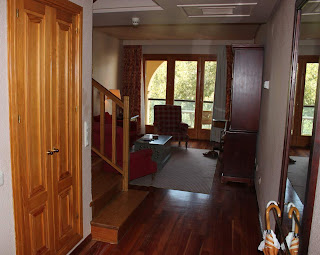Thursday
Córdoba was the capital of Baetia under the Romans, and capital of Western Islam in the 10th and 11th centuries.
 |
| Maimonides statue seen from our room |
Our hotel is in the heart of the old quarter, the most intact medieval Arabic city layout in Europe, and known, confusingly, as the Judería, or Jewish quarter, although it has been in fact home to a mixture of Jews, Christians and Muslims for centuries, and is little altered since the 13th century. We are right next to the old synagogue, one of the very few traces of Spanish Jewry to survive after their forced expulsion and conversion in 1492, and subsequent hounding by the Inquisition.
Córdoba was the greatest centre of learning in Europe in the medieval period. The philosophers Averroës and Moses Maimonides lived and worked here. The statue of Maimonides is right outside the window of our hotel room. We were also interested to read that Córdoba boasted the first automatic street lighting in Europe, around 1000 AD.
The drive through the Judería was interesting, through extremely narrow lanes full of pedestrian tourists. A Volvo estate tried to follow us and left a lot of paint and some bodywork behind.
Friday
We visit one of the wonders of the world, the Mezquita-Catedral, which isn't bad.
"Despite the presence within it of a 16th-century Christian cathedral and an older chapel, the Mezquita remains the most substantial and most impressive relic of the Islamic presence in Spain." [Roger Collins, Spain: an Oxford Archaeological Guide]
 |
| Christian vaulting above the Moorish arches |
Imposing from the outside due to its size (130 by 180m), inside it is an oasis and forest of red and white Moorish arches. When it was a mosque, it could hold 40,000 worshippers. There are many layers. A Roman temple stood here, over which was built a Christian church by the Visigoths, and then in the 8th century the construction of a mosque began.
Each rebuilding used stones, columns and capitals from the previous stages, and it was enlarged until it was the second largest in the Muslim world, the third largest ever built, the greatest in the West. When Córdoba was conquered by the Christians in 1236, the mosque was converted to a Cathedral, but they were at first respectful. A small Mudéjar chapel to complement the
Mezquita was added in 1371. In 1523 Charles V permitted the construction of the
Capilla Real and
Catedral in the centre of the mosque, although even he was said to be horrified by the results of this "desecration", as the Blue Guide describes it.. The
qibla, or South Wall, incorporating the
mihrab, was bricked up following the reconquest, and not uncovered until the nineteenth century, and so has survived well, and is very impressive.
 |
| Qibla in the Mezquita-Cathedral |
The Rio Guadalquivir was once navigable from the sea to here, and the Puente Romano dates back to the time of Julius Caesar. Apart from all of the stones having been replaced over the years, it is a real, original Roman bridge.
We considered the advice of the guide books in respect of the the
Museum of the Life of Al-Andalus in the Torre de la Calahorra - "should be every first-time visitor's initial stop in Córdoba" [Thomas Cook], "gimmicky" [both Cadogan and Rough Guide], and decided to skip it.

We paid a quick evening visit to the Alcázar, the fortress built after the conquest of Córdoba in 1238, constructed on the site of Moorish fortifications. Boabdil was held prisoner here, and Ferdinand and Isabel received Columbus before his historic journey. It was the home to the Inquisition thereafter, and a prison in the Franco years. It has some nice gardens and an excellent Roman mosaic, still underwater at the bottom of a pool in the gardens, as it was presumably originally intended.
Saturday
On leaving Córdoba, we tried to pay a visit to Medina Azahara, the ruins of a vast, fortified Arab Muslim medieval palace and city, former capital of Al-Andalus. Unfortunately, the star attraction, the restored palace, wasn't open. There is a new museum, and a bus running up to the archaeological site, but after a quick look at the museum, we decided to cut our losses and leave. Bewilderingly, the place claims to have won an award as European museum of the year 2012. All it has is a few copies of the artefacts found there, in glass cases (the originals have been distributed to proper archaeological museums), and some display boards with very poor English translations. The judges of that competition had clearly never been to a real museum, or there is something dodgy going on.









